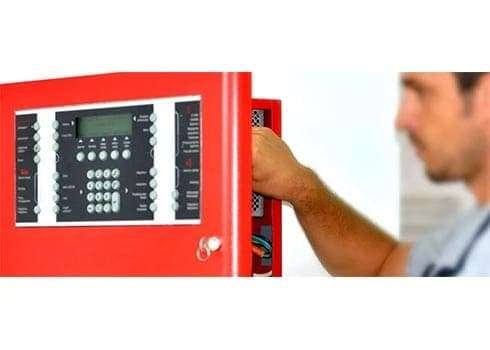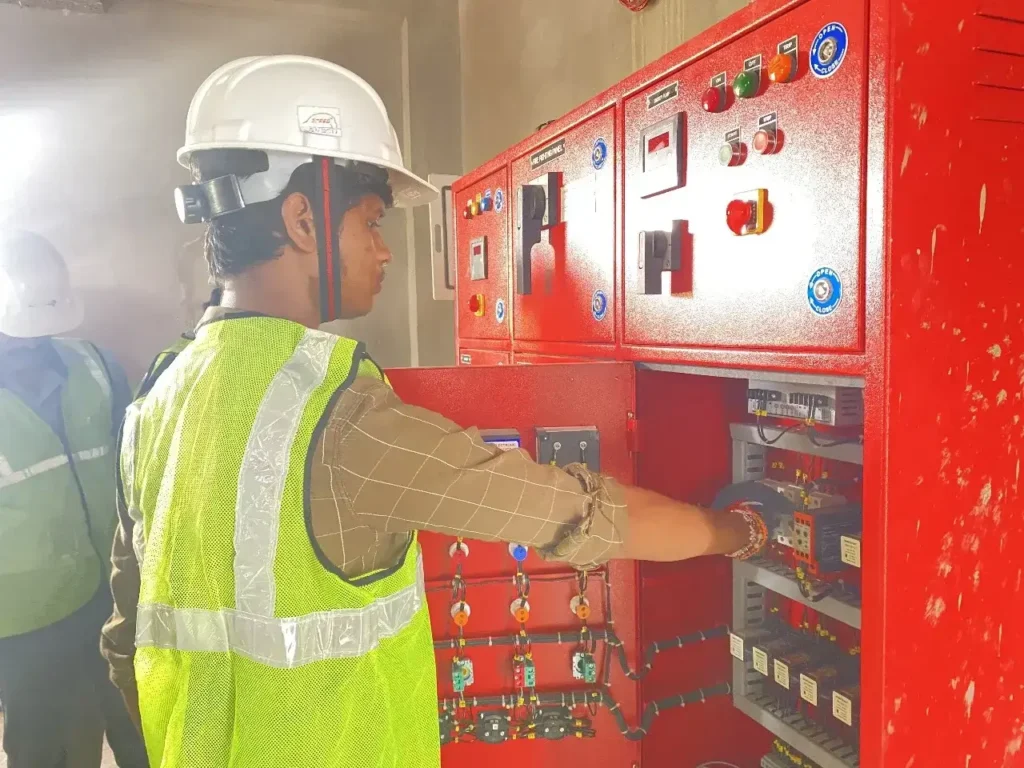Understanding Fire Safety Systems in Your Facility
As a facility manager or fire safety officer, ensuring the safety of your building and its occupants is your top priority. In today’s world, where buildings are becoming increasingly complex, having a robust fire safety system like fire annunciators is more crucial than ever. But with the rapid advancements in technology, keeping up with the latest fire safety equipment and understanding how it all works can be challenging.
That’s why we’ve created this blog series. Our goal is to demystify the key components of modern fire safety systems, starting with one of the most important yet often misunderstood devices: the fire annunciator.
In the coming sections, we’ll explore various aspects of fire safety, breaking down complex concepts into easy-to-understand information. Whether you’re a seasoned professional looking to refresh your knowledge or new to the field and eager to learn, this series will provide valuable insights to help you better manage your facility’s fire safety.
We’ll begin by diving into fire annunciators – what they are, how they work, and why they’re so crucial in your fire safety strategy. So, let’s get started on this journey to enhance our understanding and, ultimately, the safety of our facilities.
What is a Fire Annunciator?
If you’re responsible for a building’s safety, you’ve probably heard of a fire annunciator. But what exactly is it, and why is it so important? Let’s break it down in simple terms.

Understanding Fire Annunciators
A fire annunciator is a crucial part of a fire alarm system. It’s essentially a display panel that shows the status and location of various components in your fire detection system. Think of it as the ‘brain’ that processes and displays information from all the fire alarm devices in your building.
Key Components of a Fire Alarm System
To better understand fire annunciators, let’s look at the main parts of a fire alarm system:
1. Fire Alarm Control Panel: This is the central unit that monitors all the devices in your fire alarm system. The annunciator is often a part of this panel or connected to it.
2. Fire Detection Devices: These include smoke detectors, heat detectors, and manual pull stations spread throughout your building.
3. Notification Devices: These are the audible and visual alarms that alert people in case of a fire, like sirens and strobe lights.
4. Fire Annunciator: This displays information from the control panel in an easy-to-read format.

How a Fire Annunciator Works
When a fire is detected, the annunciator springs into action:
1. It receives signals from the fire alarm control panel.
2. It displays the location and type of the alarm on its screen.
3. It may show other important information, like which sprinklers have been activated.
This quick, clear information is vital for first responders and building staff to locate and address the fire promptly.
Why Fire Annunciators are Important
For facility managers and fire safety officers, fire annunciators are invaluable tools:
– They provide real-time information about the status of your fire alarm system.
– They help pinpoint the exact location of a fire, saving crucial time during an emergency.
– They can display the status of other critical systems, like sprinklers or emergency exits.
– They make it easier to conduct system tests and maintenance.
By understanding and properly using your fire annunciator, you can significantly enhance the fire safety of your facility and potentially save lives in an emergency situation.
Related Topic: Introducing Fire Hazard Annunciator System
Types of Fire Annunciators
As we delve deeper into the world of fire safety systems, it’s important to understand that not all fire annunciators are created equal. There are different types, each with its own features and benefits. Let’s explore the main types of fire annunciators and fire alarm control panels you might encounter in your facility.
1. Addressable Fire Alarm Annunciators
Addressable systems are the more modern and sophisticated option in fire alarm technology.
Key features:
– Each device (detector, pull station, etc.) has a unique address or ID.
– Provides precise location information for each activated device.
– Allows for individual device programming and sensitivity adjustment.
– Offers detailed status reports and maintenance alerts.
Benefits:
– Faster, more accurate fire location identification.
– Reduced false alarms due to adjustable sensitivity.
– Easier maintenance and troubleshooting.
2. Conventional Fire Alarm Annunciators
Conventional systems are the traditional type of fire alarm system, still common in smaller buildings.
Key features:
– Devices are grouped into zones rather than individually identified.
– Simpler in design and operation.
– Less expensive to install, but may be costlier to maintain long-term.
Benefits:
– Cost-effective for smaller facilities.
– Easier to understand and operate for non-technical staff.
– Still effective for basic fire detection and notification.
Fire Alarm Annunciator Panel Types
Regardless of whether they’re part of an addressable or conventional system, annunciator panels come in various types:
1. LED Annunciator Panels: Use lights to indicate alarm status in different zones.
2. LCD Display Panels: Provide text descriptions of alarm locations and types.
3. Graphic Annunciator Panels: Show a map of the facility with LED indicators for different areas.
4. Touch Screen Panels: Offer interactive, detailed information about the fire alarm system.
Fire Alarm Control Panel Types
The fire alarm control panel, which the annunciator is often a part of, also comes in different types:
1. Conventional Panels: Work with conventional systems, organizing devices into zones.
2. Addressable Panels: Compatible with addressable systems, offering more detailed control and information.
3. Hybrid Panels: Can work with both conventional and addressable devices, offering flexibility.
4. Wireless Panels: Use wireless technology to communicate with devices, reducing the need for extensive wiring.
When choosing a fire annunciator and control panel for your facility, consider factors like:
– The size and layout of your building
– Your budget for installation and long-term maintenance
– The level of detail you need in fire event reporting
– The technical expertise of your staff
Remember, the goal is to have a system that provides clear, actionable information in the event of a fire, helping you respond quickly and effectively to protect lives and property.
Installation and Maintenance of Fire Annunciators
Proper installation and regular maintenance of fire annunciators and control panels are crucial for ensuring the safety of your facility. Let’s dive into the key aspects of installing and maintaining these vital components of your fire alarm system.
Fire Alarm Annunciator Installation
Installing a fire alarm annunciator requires careful planning and execution:
1. Location Selection:
– Install in a readily accessible area, typically near the main entrance.
– Ensure visibility and ease of use for first responders.
2. Wiring:
– Follow local codes and manufacturer specifications for proper wiring.
– Use appropriate fire-rated cables to connect the annunciator to the main control panel.
3. Mounting:
– Securely mount at a height that’s easy to read and operate (usually eye-level).
– Ensure the mounting can support the weight of the annunciator panel.
4. Programming:
– Set up zone descriptions and customize display information as needed.
– Ensure all connected devices are properly addressed (for addressable systems).
Fire Alarm Control Panel Installation

The fire alarm control panel is the heart of your system, and its installation is critical:
1. Location:
– Install in a secure, dry area with stable temperature.
– Ensure accessibility for maintenance while keeping it secure from tampering.
2. Power Supply:
– Connect to a dedicated electrical circuit.
– Install backup batteries for uninterrupted operation during power outages.
3. Device Connections:
– Correctly wire all detectors, pull stations, and notification devices.
– Label all connections clearly for future maintenance.
4. System Programming:
– Set up all zones, devices, and notification sequences.
– Program any special functions or integrations with other building systems.
Fire Alarm System Maintenance
Regular maintenance is essential to keep your fire alarm system in top working condition:
1. Visual Inspections:
– Conduct weekly visual checks of the annunciator and control panel.
– Look for any physical damage, loose connections, or error messages.
2. Functional Tests:
– Perform monthly tests of manual pull stations and notification devices.
– Test smoke and heat detectors according to manufacturer recommendations.
3. Battery Checks:
– Test and replace backup batteries as needed, typically every 3-5 years.
4. Software Updates:
– Keep system software up-to-date with the latest versions from the manufacturer.
5. Professional Inspections:
– Schedule annual comprehensive inspections by certified fire alarm technicians.
Fire Alarm Testing Procedures

Regular testing is crucial to ensure your system will perform when needed:
1. Notification Test:
– Activate the system and verify all audio and visual alarms are working.
– Check that the correct zone information displays on the annunciator.
2. Detector Testing:
– Test smoke detectors with approved smoke aerosol.
– Test heat detectors with a heat gun (following manufacturer guidelines).
3. Battery Backup Test:
– Disconnect main power and ensure the system operates on battery backup.
4. Annunciator Function Test:
– Verify all buttons, lights, and displays on the annunciator are functioning correctly.
5. Documentation:
– Keep detailed records of all tests, including dates, results, and any issues found.
Remember, while some maintenance tasks can be performed by facility staff, others require certified professionals. Always follow local regulations and manufacturer guidelines for installation, maintenance, and testing procedures.
By properly installing and maintaining your fire annunciator and alarm system, you’re ensuring the safety of your facility and its occupants, and complying with legal requirements. Regular attention to these critical systems can literally save lives in an emergency situation.
Final Thoughts
Investing in a reliable fire annunciator system – and maintaining it properly – is an investment in the safety of your facility and the people within it. It’s not just about compliance with regulations; it’s about creating an environment where everyone can feel secure.
Remember, in the critical moments during a fire emergency, the clarity and reliability of the information provided by your fire annunciator could make all the difference. By understanding, properly installing, and diligently maintaining your fire annunciator system, you’re taking a significant step towards a safer facility.
Fire safety is an ongoing commitment. Stay informed, stay prepared, and prioritize the maintenance of your fire safety systems. Your diligence today could save lives tomorrow.








2 thoughts on “Understanding Fire Annunciators: A Comprehensive Guide”
Pingback: Mastering Smoke Detector Maintenance and Installation: Keeping Your Home Safe - Basic Elements
Pingback: Why Proper Fire Pump Room Maintenance Is Crucial for Building Safety - Basic Elements
Comments are closed.